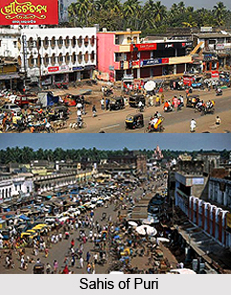 Sahis are the streets of Puri which are both large and old. The sahis are the most attracting sites at Puri. The important sahis of Puri are "Bali Sahi", "Dolamandapa Sahi", "Goudabada Sahi", "Harachandi Sahi", "Kundeibenta Sahi" and localities are "Baddei Sahi", "Balagandi Sahi", "Baseli Sahi", "Ganamala Sahi", "Gooria Sahi", "Gurruntee Haragouri Sahi", "Kalikadebi Sahi", "Karati Sahi", "Kapal Mochana", "Khatua Sahi", "Khuntia Sahi", "Kumuti Sahi", "Manikarnika Sahi", "Mausima", "Pathuria Sahi", "Patna Jenapur", "Patna Jagannathpur", "Patna Balabhadra Ballava", "Patna Matipada", "Patna Bali Sahi", "Patna Parrhee sahi", "Patna Kumbharpada", "Patna Tikarpada" and "Talichha Sahi". Sahis of Puri are very old in existence. All the Sahis near the temple are related to each other by means of the various festivals that take place in the Jagannath Temple of Puri.
Sahis are the streets of Puri which are both large and old. The sahis are the most attracting sites at Puri. The important sahis of Puri are "Bali Sahi", "Dolamandapa Sahi", "Goudabada Sahi", "Harachandi Sahi", "Kundeibenta Sahi" and localities are "Baddei Sahi", "Balagandi Sahi", "Baseli Sahi", "Ganamala Sahi", "Gooria Sahi", "Gurruntee Haragouri Sahi", "Kalikadebi Sahi", "Karati Sahi", "Kapal Mochana", "Khatua Sahi", "Khuntia Sahi", "Kumuti Sahi", "Manikarnika Sahi", "Mausima", "Pathuria Sahi", "Patna Jenapur", "Patna Jagannathpur", "Patna Balabhadra Ballava", "Patna Matipada", "Patna Bali Sahi", "Patna Parrhee sahi", "Patna Kumbharpada", "Patna Tikarpada" and "Talichha Sahi". Sahis of Puri are very old in existence. All the Sahis near the temple are related to each other by means of the various festivals that take place in the Jagannath Temple of Puri.
Some of the sahis of Puri are mentioned below:
Swarg Dwar Sahi of Puri
"Swarg Dwar Sahi" is the main market area of Puri. It is one of the oldest sahis of Puri. The Swarg Dwar Sahi is also the busiest streets of Puri which is full of shops. There are varieties of shops at this sahi which not only showcases its regional handmade products, but also serves as the centre for the sweets of Puri. They also serve the local cuisines in this street. The Swarg Dwar is the Heart of the City which is a famous shopping zone at Puri. Shops like handicrafts of Pipili and Sea Shell and various local saree shops like Ikkat, Sambalpuri, Kotki etc are also found in this street of Puri. Apart from these, Pearl Jewelleries are very famous in the Swarg Dwar Sahi.
Muchi Sahi of Puri
"Muchi Sahi" is another street of Puri which is famous for varieties of shoes. It is the only place at Puri where one can get thousands of varieties of shoes and chappals. Since this place is famous for shoes, it has got its name as "Muchi Sahi".
Dolamandapa Sahi of Puri
"Dolamandapa Sahi" is another famous sahi of Puri which leads towards the Jagannath Temple. This street is located next to the Muchi Sahi. The main dwellers of this street are the Sebakas of the Jagannath Temple. Here also the street is full of food and sweet stalls which serve the local dishes of Puri like the "Chanar Jalebi", "Gaja" and the famous "Chandani Kheer".



















